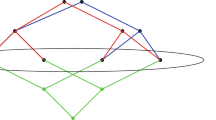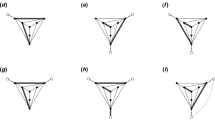Abstract
We study broadcasting, also known as one-to-all communication, in synchronous radio networks with known topology modeled by undirected (symmetric) graphs, where the interference range of a node is likely exceeding its transmission range. In this model, if two nodes are connected by a transmission edge they can communicate directly. On the other hand, if two nodes are connected by an interference edge they cannot communicate directly and transmission of one node disables recipience of any message at the other node. For a network \(G,\) we term the smallest integer \(d\), s.t., for any interference edge \(e\) there exists a simple path formed of at most \(d\) transmission edges connecting the endpoints of \(e\) as its interference distance \(d_I\). In this model the schedule of transmissions is precomputed in advance. It is based on the full knowledge of the size and the topology (including location of transmission and interference edges) of the network. We are interested in the design of fast broadcasting schedules that are energy efficient, i.e., based on a bounded number of transmissions executed at each node. We adopt \(n\) as the number of nodes, \(D_T\) is the diameter of the subnetwork induced by the transmission edges, and \(\varDelta \) refers to the maximum combined degree (formed of transmission and interference edges) of the network. We contribute the following new results: (1) We prove that for networks with the interference distance \(d_I\ge 2\) any broadcasting schedule requires at least \(D_T+\varOmega (\varDelta \cdot \frac{\log {n}}{\log {\varDelta }})\) rounds. (2) We provide for networks modeled by bipartite graphs an algorithm that computes \(1\)-shot (each node transmits at most once) broadcasting schedules of length \(O(\varDelta \cdot \log {n})\). (3) The main result of the paper is an algorithm that computes a \(1\)-shot broadcasting schedule of length at most \(4 \cdot D_T + O(\varDelta \cdot d_I \cdot \log ^4{n})\) for networks with arbitrary topology. Note that in view of the lower bound from (1) if \(d_I\) is poly-logarithmic in \(n\) this broadcast schedule is a poly-logarithmic factor away from the optimal solution.




Similar content being viewed by others
References
Alon, N., Bar-Noy, A., Linial, N., Peleg, D.: A lower bound for radio broadcasting. J. Comput. Syst. Sci. 43, 290–298 (1991)
Avin, C., Emek, Y., Kantor, E., Lotker, Z., Peleg, D., Roditty, L.: SINR diagrams: towards algorithmically usable SINR models of wireless networks. In: Proceedings of the 28th Annual ACM Symposium on Principles of Distributed Computing, PODC, pp. 200–209 (2009)
Berenbrink, P., Cooper, C., Hu, Z.: Energy efficient randomised communication in unknown adhoc networks. Theor. Comput. Sci. 410(27–29), 2549–2561 (2009)
Bermond, J.-C., Galtier, J., Klasing, R., Morales, N., Perennes, S.: Hardness and approximation of gathering in static radio networks. Parallel Process. Lett. 16, 165–184 (2006)
Brooks, R.-L.: On coloring the nodes of a network. Proc. Camb. Philos. Soc. 37, 194–197 (1941)
Chlamtac, I., Kutten, S.: On broadcasting in radio networks—problem analysis and protocol design. IEEE Trans. Commun. 33, 1240–1246 (1985)
Chlamtac, I., Kutten, S.: The wave expansion approach to broadcasting in multihop radio networks. IEEE Trans. Commun. 39, 426–433 (1991)
Cormen, T., Leiserson, C., Rivest, R., Stein, C.: Introduction to Algorithms, 2nd edn. MIT Press and McGraw-Hill (2001)
Elkin, M., Kortsarz, G.: An improved algorithm for radio broadcast. In: ACM Transactions on Algorithms 3(1), Article 8, pp. 1–21 (2007)
Gaber, I., Mansour, Y.: Centralized broadcast in multihop radio networks. J. Algorithms 46(1), 1–20 (2003)
Galčík, F.: Centralized communication in radio networks with strong interference. In : Proceedings of the 15th International Colloquium on Structural Information and Communication Complexity. SIROCCO 2008, LNCS 5058, pp. 277–290 (2008)
Gąsieniec, L.: On efficient gossiping in radio networks. In: Proceedings of the 16th International Colloquium on Structural Information and Communication Complexity SIROCCO 2009, LNCS 5869, pp. 2–14 (2009)
Gąsieniec, L., Kantor, E., Kowalski, D., Peleg, D., Su, C.: Time efficient k-shot broadcasting in known topology radio networks. Distrib. Comput. 21, 117–127 (2008)
Gąsieniec, L., Peleg, D., Xin, Q.: Faster communication in known topology radio networks. Distrib. Comput. 19(4), 289–300 (2007)
Goussevskaia, O., Moscibroda, T., Wattenhofer, R.: Local broadcasting in the physical interference model. In: Proceedings of the Workshop on Foundations of Mobile Computing DIALM-POMC 2008, pp. 35–44 (2008)
Gupta, P., Kumar, P.R.: The capacity of wireless networks. IEEE Trans. Inf. Theory 46(2), 388–404 (2000)
Kantor, E., Peleg, D.: Efficient k-shot broadcasting in radio networks. In: Proceedings of the 23rd International Symposium on Distributed Computing DISC 2009, pp. 481–495 (2009)
Kowalski, D.R., Pelc, A.: Optimal deterministic broadcasting in known topology radio networks. Distrib. Comput. 19, 185–195 (2007)
Kuhn, F., Lynch, N., Newport, C., Oshman, R., Richa, A.: Broadcasting in unreliable radio networks. In: Proceedings of the 29th Annual ACM Symposium on Principles of Distributed Computing PODC 2010, pp. 336–345 (2010)
Muetze, T., Stuedi, P., Kuhn, F., Alonso, G.: Understanding radio irregularity in wireless networks. In: 5th Annual IEEE Conference on Sensor, Mesh and Ad Hoc Communications and Networks. SECON 2008, pp. 82–90 (2008)
Onus, M., Richa, A., Kothapalli, K., Scheideler, C.: Efficient broadcasting and gathering in wireless ad-hoc networks. In: Proceedings of the 8th International Symposium on Parallel Architectures, Algorithms, and Networks ISPAN 2005, pp. 346–351 (2005)
Peleg, D.: Time-efficient broadcasting in radio networks: a review. In: Proceedings of the 4th International Conference on Distributed Computing and Internet Technology ICDCIT, LNCS 4882, pp. 1–18 (2007)
Pelc, A.: Broadcasting in radio networks. In: Stojmenovic, I. (ed.) Handbook of Wireless Networks and Mobile Computing, pp. 509–528. Wiley, New York (2002)
Acknowledgments
František Galčík was supported by the Slovak Research and Development Agency (APVV-0035-10) under contract “Algorithms, Automata, and Discrete Data Structures”, and by the Slovak Grant Agency for Science (VEGA 1/0479/12) under contract “Combinatorial Structures and Complexity of Algorithms”.
Author information
Authors and Affiliations
Corresponding author
Additional information
A preliminary version of this paper appeared in the Proceedings of PODC’09.
Rights and permissions
About this article
Cite this article
Galčík, F., Gąsieniec, L. & Lingas, A. Efficient broadcasting in radio networks with long-range interference. Distrib. Comput. 26, 59–74 (2013). https://doi.org/10.1007/s00446-012-0176-6
Received:
Accepted:
Published:
Issue Date:
DOI: https://doi.org/10.1007/s00446-012-0176-6




